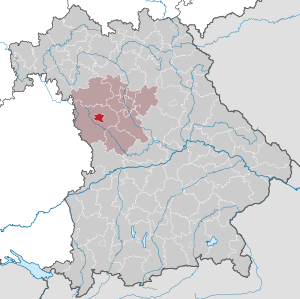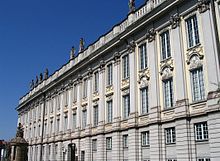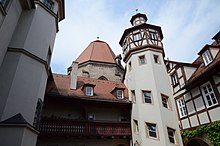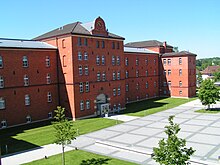Ansbach
| coat of arms | Germany map | |
|---|---|---|
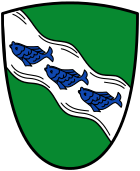
|
Coordinates: 49 ° 18 ' N , 10 ° 34' E |
|
| Basic data | ||
| State : | Bavaria | |
| Administrative region : | Middle Franconia | |
| Height : | 405 m above sea level NHN | |
| Area : | 99.91 km 2 | |
| Residents: | 41,798 (Dec. 31, 2019) | |
| Population density : | 418 inhabitants per km 2 | |
| Postal code : | 91522 | |
| Primaries : | 0981, 09802 | |
| License plate : | ON | |
| Community key : | 09 5 61 000 | |
| LOCODE : | DE ANS | |
| NUTS : | DE251 | |
| City structure: | 54 parts of the community | |
City administration address : |
Johann-Sebastian-Bach-Platz 1 91522 Ansbach |
|
| Website : | ||
| Lord Mayor : | Thomas Deffner ( CSU ) | |
| Location of the city of Ansbach in Bavaria | ||

Ansbach ( , East Franconian : Anschba ) is a Franconian city in Bavaria and is part of the Nuremberg Metropolitan Region . With over 40,000 inhabitants, Ansbach is the fourth largest city in Middle Franconia. It is the seat of the government and the district administration of Middle Franconia as well as the district office of Ansbach . In earlier times it was called "Onolzbach" or "Onoldsbach" , just like the Onolzbach stream that runs through it today .
geography
Geographical location

The city is located about 40 kilometers southwest of Nuremberg at the tributary of the Onolzbach into the Franconian Rezat , which ultimately drains to the Main . In terms of area, it is the fifth largest city in the Free State of Bavaria after Munich , Nuremberg, Augsburg and Ingolstadt .
Neighboring communities
The communities bordering on the urban area are all in the district of Ansbach :
| Lehrberg | Weihenzell | |
| Leutershausen |

|
Petersaurach , Saxony near Ansbach |
| Herrieden | Burgoberbach | Lichtenau , Weidenbach |
City structure
The municipality has 54 officially named municipal parts (the type of settlement is indicated in brackets ):
The Galgenmühle and Kammerforst have now merged into the Ansbach part of the municipality, the hammer forge in the Wallersdorf, Kaltengreuth and Pfaffengreuth part of the Eyb municipality. Ansbach forms a closed settlement with Eyb, Hennenbach, Neuses and Schalkhausen.
The living spaces Aub , beetles mill , Mittelmühle and Upper Mill are part of the community town of beetles Bach, the Brodswindener mill to Brodswinden that Höfstetter mill to Höfstetten that Neudorfer mill to Neudorf, the sub Oak Mühle to Untereichenbach that water Zeller mill to water cell, upper and Unterdautenwinden and Höfstetter Mühle form the district of Dautenwind.
Fallhaus , Voggenhof , Voggenmühle , Weidenmühle and Ziegelhütte were located in the municipality . They are all devastation now .
climate
Due to its location in Central Europe, Ansbach is in the cool, temperate climate zone . The place lies in the transition area between the humid Atlantic and the dry continental climate .
|
Average temperature and precipitation values from 1981 to 2010
Source: © Private weather station Ansbach-Schalkhausen , DWD measuring station since 1986
|
|||||||||||||||||||||||||||||||||||||||||||||||||||||||||||||||||||||||||||||||||||||||||||||||||||||||||||||||||||||||||||||||||||||||||||||||||||||||||||||||||||||
history
middle Ages
In the year 748 a Benedictine monastery was founded by the Franconian noble free Gumbert at the mouth of the Onoldsbach zur Rezat ; the most today Onolzbach written Rezatzufluss the later name is derived Ansbach. In the following centuries the monastery and the neighboring settlement grew together to form a town. The town church of St. Johannis was first mentioned in a document in 1139 . The place was first mentioned as a city in 1221.

The administrative and rulership history of the monastery and the city of Ansbach is largely in the dark. In some sources the assumption is made that the ancestors of the Eyb provided some of the monastery bailiffs.
In the years between 1144 and 1157, the lords of Schalkhausen and Dornberg , first mentioned on October 18, 1144 in a document from Bishop Embrico of Würzburg as a family called "Scalchusen", from the bishops of Würzburg with the hereditary bailiwick of the monastery and town Ansbach as well as the whole surrounding area including real estate. The seats of the noble family were the castles of Schalkhausen and Dornberg . The coat of arms of Schalkhausen is reminiscent of the earlier rule and the shape of the Ansbach city coat of arms was based on the coat of arms of Dornberg.
After the male line of Dornberg died out in 1288, the umbrella monastery ended and Ansbach came to Ludwig von Oettingen by inheritance , who was married to a daughter of Wolfram von Dornberg . In 1331 Ludwig von Oettingen sold this property to Friedrich IV , the burgrave of Nuremberg at the time .
From 1385 (until 1791) Ansbach was the capital and residence of various Zollerscher domains. When the Hohenzollern rose to Elector of Brandenburg in 1415 (under Friedrich I ) , Ansbach was not united with Brandenburg, but remained independent as Brandenburg-Ansbach . According to data from the Society for Leprology a medieval in Ansbach since 1342 Leprosorium detected, the northeast of the city in "Wolfstal" was. It was called "Feldsiechenspital" and "Siechenhaus".
16th Century
From 1523 to 1603 the Margraves of Ansbach were also dukes of Jägerndorf .
18th century
The name Ansbach appears for the first time in 1732, before that the city was called Onoltzbach and in the 18th century both names were in use at the same time for a time.
Towards the end of the 18th century there were 854 properties in Ansbach (upper quarter: 88, castle quarter: 82, Herrieder quarter: 148, upper suburb: 149, castle suburb: 77, Herrieder suburb: 224, the new display: 86 ). Most of the properties had the Ansbach council as the landlord . In addition, the Ansbach Abbey Office and the Ansbach Court Box Office were wealthy. There were also some free houses .
In 1791, the last Margrave, Karl Alexander von Brandenburg-Ansbach, renounced his territory in exchange for an annual annuity and ceded his two principalities of Ansbach and Bayreuth to Prussia , in order to live with his second wife Elizabeth Craven in England in what was then the Kingdom of Great Britain and there the Dedicate to horse breeding .
In 1796 Maximilian Joseph , Duke of Zweibrücken and Bavarian electoral pretender, chose Ansbach as his residence in exile after Zweibrücken had been occupied by France. Prussia had withdrawn from the war against revolutionary France in the Treaty of Basel in 1795 and declared its neutrality. This made the Prussian Ansbach a safe haven. Maximilian von Montgelas developed a comprehensive concept for a future radical political reorganization of Bavaria for his landless Prince Maximilian Joseph. The memorandum was edited by Eberhard Weis as Ansbacher Mémoire . After the succession of 1799 and the assumption of government of the Bavarian Elector Maximilian IV. Joseph and later (from 1806) King Max I Joseph, the Ansbach Mémoire became the conceptual basis of the modern Bavarian state.
Faience Manufactory Ansbach
Thanks to a 1709 by Margrave Wilhelm Friedrich adopted privilege that produced faience - Manufacture Ansbach from 1710. Initially (to about 1725) took Ansbach the blue and white decor of Rouen , and later expanded the range to include manganese, green and yellow. J. G. Ch. Popp succeeded in copying the Chinese decor of the Green Family - this made Ansbach famous. The pieces of this family and cold painted pieces with cherry blossoms and birds in relief decoration are particularly precious. The manufactory existed with a brief interruption from 1806/1807 until 1839.
19th century
The two parts of the country fell to the Kingdom of Bavaria , which was founded in 1806 , initially (with an occupation patent from May 20, 1806) the Ansbach area in exchange for the Wittelsbach Duchy of Berg , and in 1810 also the Bayreuth Principality, which was now administered by French.
Ansbach became the capital of the Rezatkreis formed in 1806 . With the community edict (1808), the police commissioner's office in Ansbach was formed (roughly comparable to today's independent cities ). The places Fallhaus and Ziegelhütte also belonged to this . With the second community edict (1818) Ansbach was declared a first class magistrate.
With the ordinance of November 29, 1837, the Rezatkreis became Central Franconia on January 1, 1838 . The administrative headquarters remained in Ansbach and did not come to the larger Nuremberg , as the metropolis was heavily in debt and, moreover, did not allied itself with Bavaria in the Fifth Coalition War with Napoleon in 1809 , but sided with Austria .
20th century

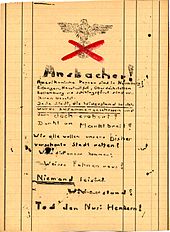
After increasing problems with the drinking water supply, the municipal waterworks in Gersbach, 25 kilometers away, went into operation in 1900 . It supplies (together with the second plant in Schlauersbach, built in 1966) 98% of the drinking water.
At a Christmas party of the NSDAP local group in Neustadt an der Aisch in 1929, the evangelical Ansbach pastor and acquaintance of Adolf Hitler's Max Sauerteig (1867–1963) described Jesus Christ as the “greatest fighter” and emphasized, among other things, the need for a God-willed and “ruthless fight” Rescue Germany. On June 11, 1934, eight theologians, including six Franconian pastors and the two theology professors Werner Elert and Paul Althaus , signed and published the Ansbach Council as a letter of protest against the Barmen Theological Declaration .
In 1940, as part of the T4 killing operation, at least 500 patients were abducted from the sanatorium and nursing home in Ansbach to the Sonnenstein and Hartheim murder centers, which were disguised as psychiatric institutions , and killed there with gas. In the Ansbach facility itself, around 50 disabled children were injected to death with the preparation Luminal in a “ children's department ” . Since 1988 a memorial plaque has been commemorating these fatalities in the Feuchtwanger Straße 38 district hospital .
The firebombing of the United States Army Air Forces in the Ansbach station district on 22 and 23 February 1945 in the framework of " Operation Clarion ," were next to the train station and much of the courtyard garden including Orangerie and the building of the former secondary school Ansbach , including the 18 Zocha castle from the 19th century , destroyed.
From March 13, 1945 to April 4, 1945, shortly before the end of the Second World War in Germany, there was a satellite camp of the Flossenbürg concentration camp , whose 700 prisoners had to do forced labor for the Reichsbahn . Between three and five prisoners died every day. At least 72 were killed in total. 58 concentration camp victims are buried in the forest cemetery, although it is uncertain whether they came from the Ansbach camp. You will be remembered there with a memorial stone.
At the end of the war, the nineteen-year-old student Robert Limpert actively campaigned for the city to be handed over to the US troops without a fight. Betrayed by the Hitler Youth , he was personally hung at the gate of the town hall by the town's combat commandant, Colonel Ernst Meyer . Several commemorative signs in the place to commemorate his planned rescue act were able to be affixed against great resistance from parts of the citizenship over the years: at the Ludwigskirche , at the grammar school Carolinum Reuterstraße 9 and at the Kronenstraße 6 . The historian Ian Kershaw described these processes.
After the end of the Second World War, Ansbach belonged to the American zone of occupation . The former margravial ambassador's house on the promenade , today the seat of the Ansbach administrative court , became the service of the American military government. The military administration set up a DP camp to accommodate so-called displaced persons in a former pulmonary hospital in today's Strüth district .
21st century

In 2009, the Ansbach rampage occurred in the local Carolinum high school , in which nine students and a teacher were injured.
In 2016 , 15 people were injured by an Islamist bomb attack at the Ansbach Open music festival , which takes place annually on the grounds of the Ansbach Reitbahn . The perpetrator died.
On July 1, 2018, the 13th Franconian Day took place in Ansbach , with the motto “Eating in Franconia”.
Incorporations
On October 1, 1970, Eyb and its districts of Kaltengreuth , Pfaffengreuth and Untereichenbach were incorporated into Ansbach.
After the regional reform in Bavaria on July 1, 1972, Ansbach was retained as an independent city . It was enlarged by incorporating seven communities in the Ansbach district and Claffheim in the Feuchtwangen district :
- Bernhardswinden with all parts of the community ( Deßmannsdorf , Kurzendorf and Meinhardswinden ).
- Brodswinden with all parts of the community ( Gösseldorf , Höfstetten , Wallersdorf and Wolfartswinden ). The municipality of Brodswinden was expanded after 1966 to include part of the non-municipality Feuchtlach , a forest area.
- Claffheim with all parts of the municipality ( Hohe Fichte and Winterschneidbach ).
- Elpersdorf with all parts of the municipality ( Dautenwind , Dombach im Loch , Höfen , Käferbach , Liegenbach , Mittelbach , Oberdombach , Windmühle (near Elpersdorf) and Wüstenbruck ).
- Hennenbach with all parts of the community ( Egloffswinden , Kammerforst , Katterbach , Obereichenbach and Wengenstadt ).
- Neuses b. Ansbach with all parts of the community ( Strüth and Wasserzell ).
- Schalkhausen with all parts of the community ( Dornberg , Geisengrund , Neudorf and Steinersdorf ). After 1966, the community of Schalkhausen was expanded to include part of the community-free area Feuchtlach.
The city of Ansbach became the administrative seat of the new district of Ansbach .
Place name
The place name is documented as Onoltesbach (around 790), Onoltespah (837), Onoldesbach (1141), Onoldsbach (1230), Onelspach (1338), Onsbach (1508) and Onolzbach (1530) or Ansbach (1732). Another historical spelling is Anspach , the Latin name is Onoldium .
The name refers to the water body name Onoldisbach (today's Onolzbach ) with the Old High German pah or bach for stream, small watercourse and the personal name Onold .
Religions
Christianity

In addition to the Evangelical Lutheran Church in Bavaria and the Catholic city dean of Ansbach within the Archdiocese of Bamberg , the following Christian communities are represented in Ansbach:
- New Apostolic Church
- Seventh-day Adventists
- Methodist Church
- Mission church Ansbach
- Free evangelical community
- Popular mission of resolute Christians
- Baptists
There are two German-speaking congregations of Jehovah's Witnesses in Ansbach , as well as one Russian-speaking congregation. Services are also held in English and Romanian. The Church of Jesus Christ of Latter-day Saints ( Mormons ) is also represented.
Judaism
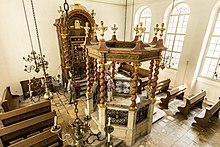
Jewish families had lived in the village at least since the end of the 18th century . They established a Jewish cemetery on Rügländer Strasse , which was desecrated and leveled during the Nazi tyranny . Restored in 1946, it has been desecrated several times since then. A plaque on the cemetery wall reminds of this. The Jewish community built its synagogue at Rosenbadstrasse 3 from 1744 to 1746 , which was also desecrated by SA men during the November pogrom in 1938 , but was not burned down to protect neighboring buildings. Today it serves as a “symbolic house of God”. A memorial plaque in the anteroom commemorates the synagogue and the Jewish residents who fell victim to the genocide of the Jews by the National Socialists.
Islam
With the influx of guest workers from predominantly Muslim countries, there are also some small Muslim communities.
Buddhism and Hinduism
There has been a small Buddhist temple since 2005 and a small Hindu community since 2007 .
politics
Lord Mayor
- 1877–1905: Ludwig Keller ( DFP )
- 1905–1919: Ernst Rohmeder
- 1919–1934: Wilhelm Borkholder (from 1933 NSDAP )
- 1934–1945: Richard Hänel (NSDAP)
- 1945: Hans Schregle ( SPD ), deployed by the US military administration
- 1945–1950: Ernst Körner (SPD)
- 1950–1952: Friedrich Böhner
- 1952–1957: Karl Burkhardt ( CSU )
- 1957–1971: Ludwig Schönecker (CSU)
- 1971–1990: Ernst-Günther Zumach (CSU)
- 1990-2008: Ralf Felber (SPD)
- 2008–2020: Carda Seidel ( independent )
- since May 1, 2020: Thomas Deffner (CSU)
City council
The last local elections resulted in the following allocation of seats in the city council :
| Parties and groups of voters | 2002 | 2008 | 2014 | 2020 |
|---|---|---|---|---|
| CSU | 16 | 13 | 12 | 11 |
| SPD | 11 | 9 | 8th | 5 |
| GREEN | 2 | 5 | 4th | 5 |
| ÖDP | 3 | 3 | 4th | 3 |
| AfD | - | - | - | 3 |
| Free voters (FW) | 0 | 2 | 3 | 3 |
| Open Left Ansbach (OLA) | 0 | 1 | 3 | 3 |
| Citizens' Initiative Ansbach Non-Party (BAP) | 8th | 7th | 6th | 5 |
| The Ansbacher | - | - | - | 2 |
| total | 40 | 40 | 40 | 40 |
badges and flags
|
Blazon : "A silver diagonal wave bar in green, covered with three blue fish swimming one behind the other."
The municipal flag has been white and green since the 17th century |
|
| Justification of the coat of arms: The city has had a coat of arms since the 14th century, in which wavy lines appear for the first time in 1532 , representing the Onolzbach river . Fish have been mentioned as part of the coat of arms since 1530, but have only been seen commonly in illustrations since the end of the 17th century. Until about 1580 the field color was red , since then it has been green . The (red) coat of arms without fish is z. B. can be seen at Herrieder Tor and at the Markgraf-Georg-Brunnen in front of the town hall . |
Town twinning
Four city partnerships:
-
 A partnership was agreed with Bay City in the USA as early as 1960.
A partnership was agreed with Bay City in the USA as early as 1960. -
 The partnership with the city of Anglet in France has existed since July 17, 1968 .
The partnership with the city of Anglet in France has existed since July 17, 1968 . -
 In 2004 a new partnership was concluded with the Chinese town of Jingjiang .
In 2004 a new partnership was concluded with the Chinese town of Jingjiang . -
 In 2006 another partnership was established with the Italian city of Fermo .
In 2006 another partnership was established with the Italian city of Fermo .
Sponsored city
Ansbach has been the godfather town of Krnov (Jägerndorf) in the Czech Republic since June 21, 1954 . The sponsorship arose mainly from the old historical connection with the Duchy of Jägerndorf and from the efforts of the Free State of Bavaria to integrate the Sudeten Germans economically, culturally and socially. The founder of the Jägerndorfer Heimatarchiv in the sponsored town of Ansbach, Professor Ernst Kober, born on September 4, 1885 in Deutsch Liebau in Moravia, died on November 30, 1963 in Ansbach and was buried at the city cemetery. He was the father of the sponsorship. Together with the specialist teacher Konorza, who was elected to the Ansbach city council in 1953 through the Association of Expellees (BdV), the path to sponsorship could be prepared under the then Lord Mayor Burkhardt - who later became President of the District Council.
In the Jägerndorfer Heimatstuben in the rear building of the old town hall on Martin-Luther-Platz, exhibits from the history of the Duchy of Jägerndorf can be viewed in six rooms. The Jägerndorfer Heimatarchiv is located in the cultural center (city archive) on Karlsplatz.
Culture and sights
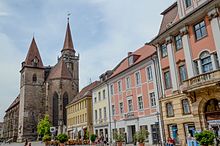
Theaters and other facilities
- Ansbach theater
- Kammerspiele Ansbach
- Theater upside down
- LOFT. Space for art & the present
Museums
- Margrave Museum (with Kaspar Hauser department)
Buildings
- The residence developed from a medieval complex. The large Gothic hall with its ribbed vault was built around 1400 . The largest collection of faience and porcelain from the former Ansbach factory is on display here. The last renovations took place between 1705 and 1730, the interior decoration dates from between 1734 and 1745 (architect Leopoldo Retti ). Since the last Margrave of Brandenburg-Ansbach handed over the residence to the Kingdom of Prussia when he abdicated in 1791 , the castle was no longer the seat of the ruler, the rooms were no longer modernized according to contemporary tastes and are therefore largely preserved. The ceiling fresco by Carlo Carlone in the ballroom, the Rococo painting gallery , paintings from the former margravial gallery and a collection of Meissen porcelain in the mirror cabinet are well worth seeing .
- Orangery in the margravial courtyard garden
- A garden is first mentioned at the beginning of the 16th century in Leonhart Fuchs' book of herbs . A pleasure and opera house was built here in 1596, which was replaced by an orangery in the 1720s. Between 1723 and 1750 the complex was redesigned to create a baroque garden. During the Second World War , the orangery building and garden were badly damaged and later rebuilt in the style of the 17th and 18th centuries. Today there is also a herb garden with many medicinal plants and a citrus house for the wintering of the container plants.
- At the site of today's church building, the confluence of Onoldsbach and Rezat, the Franconian noble free Gumbert founded a Benedictine monastery in 748 . In the period that followed, a settlement developed around the monastery, from which the town of Onoldsbach / Ansbach developed. The sacred building combines the changing architectural styles of the 11th to 18th centuries. The oldest part of the church is the Romanesque crypt under the altar (around 1040). The north aisle with the St. George's Chapel dates from the 14th century, the Swan Knight's Chapel from the early 16th century. The bell tower was built in 1594 and the baroque nave in 1738. The Gumbertus Church also has the largest baroque organ in the Franconian region.
- the Behringerhof , former sexton of the Gumbertus monastery
- former margravial court chancellery, built 1594–97 by Gideon Bacher in place of the former monastery building by St. Gumbertus
- St. John's Church , built in the 15th century in a uniform Gothic style, formerly the town church of the medieval parish of Ansbach
- Ludwigskirche , in the style of Munich Classicism, built 1834–1840 by Leonhard Schmidtner
- Catholic Christ-König-Kirche , octagon building made of concrete and glass, built 1962–1965 in the Rügländerviertel.
- Synagogue , built in the 1740s, not destroyed in the Reichspogromnacht 1938
- Herrieder Tor , former city gate, built in the 15th century, redesigned to its present form in 1750/51
- Carolinum grammar school , founded in 1528 and thus the second oldest non-monastic grammar school in Bavaria
- Buildings by Leopoldo Retti, including the Retti-Palais planned as his own home
- Monument to August Graf von Platen by Johann von Halbig
- Kaspar Hauser monument
- Memorial to Johann Peter Uz in the Hofgarten
- Telecommunications tower ( type tower FMT 16, height: 137.5 meters, not accessible to the public)
- Bismarck tower , built in 1903 12.7 m high observation tower on the Kaiserhöhe
- Former warning office IX with bunker system near Ansbach-Claffheim, not open to the public
- Schwarzer Bock , a listed historic inn and hotel
- former widows house
- the Eybhof , birthplace of Theodor Escherich , oldest private stone house in Ansbach
Protected areas
In Ansbach there is a nature reserve , two landscape protection areas and three designated fauna-flora-habitat areas (as of March 2016).
Natural monuments
- About 500 years old cross mark , northwest of Ansbach near Hürbel am Rangen .
Sculpture Mile
"Sculpture miles" have been taking place in Ansbach since 2003. In the summer months, works by changing artists are exhibited in the public space of the city center. The Sculpture Mile took place annually from 2003 to 2009, since then every two years.
List of artists:
- 2003: Jürgen Goertz (sculptures), Christa Goertz (pictures) (subject: Ansbach inspires ... )
- 2004: Thomas Röthel , Bettina Schluesselburg
- 2005: Claude Viseux
- 2006: Walter Kopp
- 2007: Kurt Laurenz Metzler
- 2008: Quirin Mayer
- 2009: Ernst Steinacker
- 2011: Rolf Szymanski
- 2013: Ottmar Hörl (Subject: Installation project The artist Kaspar Hauser )
- 2015: Dietrich Klinge (topic: locations )
- 2017: Herbert Mehler , Thomas Röthel (Subject: Steel Worlds )
- 2019: Antje Tesche-Mentzen (subject: music made of bronze )
Sports
Ansbach became known throughout Germany in the 1960s when TSV 1860 Ansbach won the German field handball championship twice between 1960 and 1962 . The basketball department played as hapa Ansbach in the ProB league (third division), but was also second class before . Furthermore, the Ansbacher Grizzlies were German champions in American football in 1981, 1982 and 1985 . Ansbach has also been a stage location for important German cycling races several times . In 2000 and 2003, one stage of the Germany Tour ended in Ansbach, and in 2001 the Bavarian Tour was a guest in the royal seat.
- List of important sports clubs
- SpVgg Ansbach 09 (football, karate, tennis, pétanque)
- Ansbach Grizzlies (American Football)
- Cycling community Ansbach (cycling, cycling, triathlon / duathlon)
- Judo Team Ansbach (Judo)
- TSV 1860 Ansbach (basketball as hapa Ansbach piranhas , handball, athletics, tennis, ...)
- TSV Fichte Ansbach (football, tennis, ...)
- HG Ansbach (handball, handball community of the clubs TSV 1860 Ansbach and TSV Fichte Ansbach)
- ESV Ansbach-Eyb (football, tennis, ...)
- SV Schalkhausen (football, tennis, ...)
- TSV Brodswinden (football, tennis, ...)
- TSV Elpersdorf (football, tennis, ...)
- SV Meinhardswinden (soccer)
Regular events
- Kontakta Ansbach , leisure and consumer fair (every two years in even years, March / April)
- Reading Pleasure (annually, April)
- City run (annually, May)
- Spring Festival (annually, May)
- Old Town Festival (annually, May / June)
- International guitar concerts Ansbach (annually, May – October)
- Cultural evening of the university (annually, June)
- Summer party of the university (annually, June)
- Rococo Festival (annually, June / July)
- Parish fair (annually, July)
- Festival parade (every two years in even years, July)
- City moat festival (annually, July), which includes the children's festival in the city moat on the Saturday of the festival weekend
- Green Night (biennially in even years, July)
- Sculpture Mile (every two years in odd years, summer months)
- Ansbach Open (annually, July / August)
- Kaspar Hauser Festival (every two years in even years, July / August)
- Bach Week Ansbach (every two years in uneven years, July / August)
- Ansbacher Bardentreffen (annually, September)
- Comic exchange (annually, October)
- LesArt , readings by well-known authors at various locations; next to Ansbach in Fürth , Lauf an der Pegnitz and Schwabach (annually, November)
- Academic evening of the university (annually, November)
- Pub Hunt (annually, November)
- Christmas market (annually, November / December)
- Long culture and shopping night (annually, December)
Economy and Infrastructure
In 2016, Ansbach achieved a gross domestic product (GDP) of € 2.325 billion within the city limits . In the same year, GDP per capita was € 56,230 (Bavaria: € 44,215, Germany € 38,180) and thus well above the regional and national average. In 2016 there were around 36,900 employed people in the city. The unemployment rate in December 2018 was 3.4% (in the Ansbach district it was 2.1%).
In the Future Atlas 2019 , the independent city of Ansbach was ranked 51st out of 401 rural districts and independent cities in Germany, making it one of the places with "high future opportunities".
Companies
The city is known for its plastics processing companies ( Oechsler AG , Heinlein Plastik, etc.) and the automotive supply industry. The Robert Bosch GmbH in the district Brodswinden with its 2500 employees, is one of the most important employers in Ansbach. Pigrol Farben GmbH, which took over Kulba Bauchemie in 2002, is a well-known manufacturer of wood and building protection based in Ansbach. Diehl Metering GmbH (until September 30, 2014 Hydrometer GmbH ), a world-famous manufacturer of water and heat meters, which is part of the Diehl Group , has its headquarters in Ansbach-Eyb . The Brücken-Center shopping center, built in 1997, is located northwest of the old town . The factory for the worldwide BiFi production of mini salamis is also located in Ansbach .
traffic
Road traffic
Ansbach is located on the federal motorway 6 and can be reached via the junctions Ansbach, Herrieden / Ansbach-West and Lichtenau. Furthermore, the federal highway 13 and the federal highway 14 run through the city area.
License Plate
On July 1, 1956, the city was assigned the distinctive sign AN when the vehicle license plates were introduced . It is continuously issued to this day and is also used by the Ansbach district .
Rail transport
The Ansbach station is a hub station, located near railroad tracks Nuremberg - Crailsheim and Treuchtlingen - Würzburg . The city's only passenger station is a long-distance stop and is served every two hours by intercity trains in the direction of Stuttgart / Karlsruhe or Nuremberg . There are also a few intercity connections to Hamburg-Altona and Munich or Berchtesgaden .
On the Nuremberg-Crailsheim railway Ansbach is as part of the Transport Network greater Nuremberg with the line S4 to the quick transport of the metropolitan area Nürnberg connected.
Air traffic
The airfield Ansbach- Petersdorf is a small air space between the neighboring communities Bruckberg and Weihenzell. The next international airport is in Nuremberg .
Public transport
The urban bus with seven lines of the Ansbacher baths and traffic operated GmbH. This is a member of the Transport Association for Greater Nuremberg (VGN).
media
Print media and internet
- Fränkische Landeszeitung (FLZ), daily newspaper in association with the Nürnberger Nachrichten (NN); with the advertising paper Woche im Blick (WiB)
- Fränkischer.de - The online news portal for the city and district of Ansbach
- WochenZeitung (WZ)
- ANBLICK - The city magazine for Ansbach and the surrounding area
- KASPAR - the city magazine of the Ansbach University of Applied Sciences
- Ansbach Plus , an online magazine
Broadcasting and broadcasting systems

The radio programs Radio 8 and Radio Galaxy are located in Ansbach .
Ansbach is the location of three transmitter systems :
- Ansbach transmitter on Ludwigshöhe,
- Katterbach transmitter location of the American troops,
- Galgenmühle transmitter location .
|
Frequency ( MHz ) |
program | RDS PS | Regionalization |
ERP ( kW ) |
Transmission diagram round [ND] / directional [D] |
Polarization horizontal [H] / vertical [V] |
|---|---|---|---|---|---|---|
| Radio programs broadcast by the Ansbach / Ludwigshöhe transmitter | ||||||
| 89.4 | Radio 8 | RADIO 8 | - | 0.5 kW | ND | H |
| 105.8 | Radio Galaxy | GALAXY | Ansbach | 0.1 kW | D. | H |
| Radio program broadcast by the Ansbach / Katterbach transmitter | ||||||
| 107.3 | AFN - The Eagle | - | Bavaria | 0.25 kW | D. | H |
| Radio programs broadcast by the Ansbach / Galgenmühle transmitter | ||||||
| 92.7 | Deutschlandfunk | DLF | - | 0.2 kW | D. | H |
| 102.7 | Deutschlandradio Kultur | DKULTURE | - | 0.2 kW | D. | H |
Public facilities
- Ansbach has a high proportion of employees in the public sector due to the seat of the district government, supra-regional authorities and courts such as the administrative court and a senate of the Bavarian Administrative Court (BayVGH).
- Middle Franconia district
- District clinics in Middle Franconia with the district clinic in Ansbach (psychiatry, psychotherapy and psychosomatic medicine and geriatric rehabilitation)
- Ansbach Clinic (ANregiomed)
- Evangelical Luth. Regional church office
- Ansbach District Court
- Ansbach district court
- Administrative court of Ansbach
- Ansbach branch of the Bavarian Administrative Court
- Ansbach tax office with branches in Rothenburg and Dinkelsbühl
- State Office for Data Protection Supervision
- State Office for Finance (formerly District Finance Directorate)
- Office for Food, Agriculture and Forests Ansbach with branches in Dinkelsbühl, Rothenburg and Heilsbronn (Forests area)
- Office for Rural Development Middle Franconia (formerly Land Consolidation Directorate)
- Correctional facility
- Kulturzentrum am Karlsplatz (Karlshalle, City Archives, Angletsaal)
- Volunteer fire brigade of the city of Ansbach
- Criminal Police Inspection , Police Inspection and Traffic Police Inspection of the Bavarian Police
- State Audit Office Ansbach
- Technical relief organization ( THW ) in EYB
education
- State Finance School Bavaria
- Ansbach University
- State Institute Ansbach for the training of specialist teachers at general schools (Department III) and at vocational schools (Department IV)
- Theresien-Gymnasium
- Platen high school
- Carolinum High School
- State Realschule Ansbach (Johann Steingruber School)
- Mechanical Engineering School Ansbach (with a technical school for mechanical engineering and a specialist academy for medical technology)
- State technical and vocational high school
- Municipal business school
- State vocational school I with vocational school for technical assistants for computer science
- State vocational school for special needs education (focus on learning)
- State vocational school center, consisting of vocational school II and vocational schools for home economics, child care and social care
- Evangelical School Ansbach
- Friedrich Güll School Ansbach
- Weinbergschule Ansbach Elementary and secondary school
- Waldschule Ansbach Primary and secondary school
- Luitpold School Ansbach
- Brodswinden primary school
military
Until 1992, d. H. before the establishment of Ansbach University (1996) and the construction of the Bridge Center (1997), was in the city on today's state road 13 / 14 the Hindenburg barracks . Built in the time of the margraves and occupied by mounted troops, after their expansion in the Kingdom of Bavaria there were successively (from 1815 to 1867) the KB 2nd Chevaulegers Regiment and (from 1868 to 1919) the KB 2nd Uhlan Regiment “König of Bavaria ” . At the time of the Weimar Republic there were no troops in Ansbach. From 1936 to 1945 the Artillery Regiment 53 of the Wehrmacht was stationed in the barracks . After that, the facilities were used by the US Army Europe .
In the south of the city, the Bleidorn barracks (named after Rudolf Bleidorn , General of the Artillery of the Reichswehr ) was inaugurated as Barracks Am Wasserturm . It initially served as a barracks for the Wehrmacht. After the end of the war, displaced persons were housed here until 1949 . The area was used militarily by the US Army from late 1949 to 1992. After the Free State of Bavaria had acquired parts of the area, one building served temporarily as accommodation for asylum seekers , other areas are used by the police and the state institute, while the rest is used by the U.S. Army Garrison Ansbach (USAG) under the name Bleidorn Housing .
Also to the south are the Barton Barracks (named after David B. Barton, Lieutenant Colonel of the US armed forces and killed in World War II) on Meinhardswindener Straße , where the USAG headquarters are located. The barracks were built from 1936 to 1938 and were initially called barracks on Ludwigshöhe or Gneisenau barracks .
In the district of Katterbach in the northeast is the Ansbach-Katterbach airfield ( Ansbach Army Heli Pad (Ansbach AHP) ) of the US Army, which also operates the Shipton barracks in neighboring Obereichenbach .
Telephone prefixes
In Ansbach the area code 0981 applies. In deviation from this, the following area codes apply:
- 09802 in Katterbach and Obereichenbach,
- 09805 in Claffheim, Hohe Fichte and Winterschneidbach
- 09820 in Neudorf and Steinersdorf,
- 09823 in Höllmühle,
- 09825 in Käferbach
Personalities
literature
Monographs
- Hermann Dallhammer: Ansbacher Chronicle: Small Residence, Big Wide World. Ansbacher Museums-Verlag, 1979, DNB 800254988 .
- Hermann Dallhammer: Ansbach: history of a city. Hercynia Verlag, Ansbach 1993, ISBN 3-925063-35-8 .
- Johann Bernhard Fischer: History and detailed description of the city of Anspach. Anspach 1786 ( e-copy ).
- Diana Fitz: Ansbach under the swastika. Ansbach 1994, DNB 943208262 .
- August Gebeßler : Ansbach. ( Deutsche Lande - German Art ). Munich / Berlin 1964, DNB 451450906 .
- Hans-Martin Goede: The weather in Ansbach in retrospect from 1981 to 2010. Ansbach 2011, ISBN 978-3-932884-11-5 .
- Aaron Bär Grünbaum : The inheritance of the fathers. Sermon held at the secular festival of the synagogue in Ansbach. Along with some notes on the history of the Israelite community. Ansbach 1846.
- Lara Hausleitner: 60 years later: Air raids & end of the war in Ansbach. Contemporary witnesses report. Ed .: Fränkische Landeszeitung and City of Ansbach. Ansbach 2005.
- Lara Hausleitner: 60 years later: a new beginning in peace. Contemporary witnesses report. Ed .: Fränkische Landeszeitung and City of Ansbach. Ansbach 2006.
- Manfred Jehle: Ansbach: the margravial chief offices Ansbach, Colmberg-Leutershausen, Windsbach, the Nuremberg nursing office Lichtenau and the Deutschordensamt (Wolframs-) Eschenbach (= historical atlas of Bavaria, part Franconia . I, 35). Commission for Bavarian State History, Munich 2009, ISBN 978-3-7696-6856-8 .
items
- Engineer officers in Ansbach. In: Norbert Hierl-Deronco: It is a pleasure to build, from builders, builders and from building in the baroque in Kurbayern-Franconia-Rhineland. Krailling 2001, ISBN 3-929884-08-9 .
- Johann Kaspar Bundschuh : Anspach . In: Geographical Statistical-Topographical Lexicon of Franconia . tape 1 : A-egg . Verlag der Stettinische Buchhandlung, Ulm 1799, DNB 790364298 , OCLC 833753073 , Sp. 137-159 ( digitized version ).
- Elisabeth Fechter: The place names of the district of Ansbach . Inaugural dissertation. Erlangen 1955, DNB 480570132 , p. 39-42 .
- Günther P. Fehring : City and district of Ansbach (= Bavarian art monuments . Volume 2 ). Deutscher Kunstverlag, Munich 1958, DNB 451224701 , p. 3-76 .
- Georg Paul Hönn : Anspach . In: Lexicon Topographicum of the Franconian Craises . Johann Georg Lochner, Frankfurt and Leipzig 1747, p. 313-314 ( digitized version ).
- Wolf-Armin von Reitzenstein : Lexicon of Franconian place names. Origin and meaning . Upper Franconia, Middle Franconia, Lower Franconia. CH Beck, Munich 2009, ISBN 978-3-406-59131-0 , p. 25 .
- Gottfried Stieber: Anspach . In: Historical and topographical news from the Principality of Brandenburg-Onolzbach . Johann Jacob Enderes, Schwabach 1761, p. 201-234 ( digitized version ).
- Pleikard Joseph Stumpf : Ansbach . In: Bavaria: a geographical-statistical-historical handbook of the kingdom; for the Bavarian people . Second part. Munich 1853, p. 664-666 ( digitized version ).
- Wolfgang Wüst : Life between courtly luxury and economic tightness. The residences of the bishops of Augsburg and the Franconian Hohenzollern in absolutism. In: ZHVS 99. (2006) pp. 111-134.
Web links
- Homepage
- Ansbach . In: Meyers Konversations-Lexikon . 4th edition. Volume 1, Verlag des Bibliographisches Institut, Leipzig / Vienna 1885–1892, p. 614.
- Ansbach: Official statistics of the LfStat
- Ansbach Plus , Wiki about the city of Ansbach
Individual evidence
- ↑ "Data 2" sheet, Statistical Report A1200C 202041 Population of the municipalities, districts and administrative districts 1st quarter 2020 (population based on the 2011 census) ( help ).
- ^ City of Ansbach: Lord Mayor. Retrieved May 24, 2020 .
- ^ Elisabeth Fechter: The place names of the district of Ansbach. 1955, p. 39.
- ^ Ansbach community in the local database of the Bavarian State Library Online . Bavarian State Library, accessed on September 16, 2019.
- ↑ Bavarian State Office for Statistics and Data Processing (Ed.): Official local directory for Bavaria, territorial status: May 25, 1987 . Issue 450 of the articles on Bavaria's statistics. Munich November 1991, DNB 94240937X , p. 323 ( digitized version ).
- ↑ a b Listed as a district in the official registers until 1900.
- ↑ Listed as a district in the official registers until 1885.
- ↑ Private weather station
- ↑ a b c d e f Entry on the coat of arms of Ansbach in the database of the House of Bavarian History
- ↑ Mention of the Eyb, p. 61 .
- ↑ Jenaische Allgemeine Literatur-Zeitung, Volume 61, p. 431 - Die Vögte (Advocaten) von Dornberg .
- ↑ Mention of the coat of arms of the bailiffs of Schalkhausen and Dornberg, p. 65 .
- ↑ Mention of the marriage of Ludwig von Oettingen, p. 17 .
- ^ Prehistory of the city and the former principality of Ansbach (1868); Jacobi, Friedrich, from p. 62 .
- ^ Franconia - Contributions to the history, topography and literature of Franconia, Ansbach 1813, Volume 2 .
- ↑ Local history theme for 2015: 600 years of the Brandenburg-Ansbach Margraviate. (PDF; 1.28 MB) Roth district , 2015, accessed on August 1, 2016 .
- ↑ See Medieval Leprosories in Today's Bavaria, No. 56, Documentation, originally in: Die Klapper 1995, accessed on February 10, 2018 ( Memento from March 4, 2016 in the Internet Archive )
- ↑ M. Jehle, Vol. 2, pp. 828-834.
- ↑ Eberhard Weis : Scientific Edition of the Ansbacher Mémoire (translation: Das Ansbacher Mémoire )
- ^ "Possession-seizure patent for the Margraviate of Ansbach" from May 20, 1806
- ↑ Alphabetical index of all the localities contained in the Rezatkkreis according to its constitution by the newest organization: with indication of a. the tax districts, b. Judicial Districts, c. Rent offices in which they are located, then several other statistical notes . Ansbach 1818, p. 111 ( digitized version ).
- ↑ Horst M. Auer: Nuremberg chances-free - Why Middle Franconia is governed from Ansbach. In: Nürnberger Nachrichten , November 19, 2012, p. 14.
- ^ Wolfgang Mück: Nazi stronghold in Middle Franconia: The völkisch awakening in Neustadt an der Aisch 1922–1933. Verlag Philipp Schmidt, 2016 (= Streiflichter from home history. Special volume 4); ISBN 978-3-87707-990-4 , pp. 84, 90 f. and 263 f.
- ^ A b c d e Hermann Dallhammer, Werner Bürger: Ansbach: History of a city . Hercynia, Ansbach 1993, ISBN 978-3-925063-35-0 .
- ^ Website of the Flossenbürg Concentration Camp Memorial . Retrieved July 6, 2016.
- ↑ Memorial sites for the victims of National Socialism. A documentation. Volume 1. Federal Agency for Civic Education , Bonn 1995, ISBN 3-89331-208-0 , p. 113 f.
- ↑ Ian Kershaw: The Eternal Question "Why?" , SRF , June 3, 2012, minute 12:50 to minute 19:40.
- ↑ Blood deed at Ansbach school: gunman attacked students with ax and knives. Spiegel Online , accessed September 17, 2009 .
- ↑ Spiegel Online : 27-year-old kills himself in a crowd with explosives , from July 25, 2016
- ^ Wilhelm Volkert (ed.): Handbook of Bavarian offices, communities and courts 1799–1980 . CH Beck, Munich 1983, ISBN 3-406-09669-7 , p. 600 .
- ↑ a b c Georg Rüxner : Thurnier book: from the beginning, causes, origin, and come from, the Thurnier in the holy Roman Empire of the Teutscher Nation ... ( digitized version )
- ↑ a b Reitzenstein, p. 25.
- ↑ Anspach-Baireuth. (No longer available online.) Archived from the original on September 24, 2015 ; Retrieved June 24, 2013 .
- ^ Heinz Bischof, Wilhelm Sturmfels: Our place names. In the ABC explained according to origin and meaning. Dümmler Verlag, Rastatt 1961, p. 19.
- ↑ Report of the district government of Middle Franconia on religious affiliation, Nuremberg 2007.
- ^ City of Ansbach - city council election 2020
- ↑ City council election 2020. City of Ansbach, March 16, 2020, accessed on March 19, 2020 .
- ↑ City arms. City of Ansbach, accessed on October 25, 2014 .
- ↑ Ansbach. In: Kommunalflaggen.eu. Retrieved February 14, 2020 .
- ↑ Important dates ( Memento of February 13, 2013 in the Internet Archive ), accessed on August 15, 2014.
- ↑ Town twinning of Anglet ( Memento of July 14, 2014 in the Internet Archive )
- ↑ Sponsorship Ansbach-Jägerndorf
- ↑ Bismarckturm Ansbach on www.bismarcktuerme.de.
- ↑ Ansbach Sculpture Mile , City of Ansbach.
- ↑ Current results - VGR dL. Retrieved January 7, 2019 .
- ↑ State of Bavaria. Federal Employment Agency, accessed on January 7, 2019 .
- ↑ Future Atlas 2019. Retrieved on October 24, 2019 .
- ↑ Hydrometer is now called Diehl Metering. (No longer available online.) Diehl , October 1, 2014, archived from the original on October 6, 2014 ; accessed on October 22, 2014 .
- ^ Diehl Metering GmbH, Ansbach. (No longer available online.) Diehl , 2014, archived from the original on October 19, 2014 ; accessed on October 22, 2014 .
- ↑ Online magazine. Ansbach Plus, accessed October 23, 2013 .
- ↑ David B. Barton 1923; Cullum No. 7105; Jun 03, 1944; Died in Velletri, Italy. westpointaog.org, accessed October 18, 2014 .

